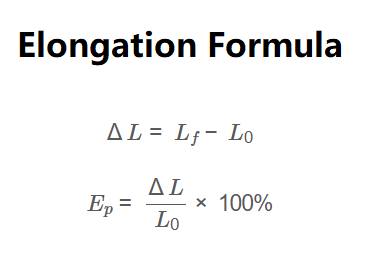1. What is Elongation Calculator?
Definition: This calculator computes the change in length (\( \Delta L \)) and the elongation percent (\( E_p \)) of a rod under tensile load, representing the engineering strain.
Purpose: It is used in material science and engineering to analyze the deformation of materials under tensile stress, helping to understand material behavior and properties.
2. How Does the Calculator Work?
The calculator uses the following formulas:
Formulas:
\[
\Delta L = L_f - L_0
\]
\[
E_p = \frac{\Delta L}{L_0} \times 100\%
\]
Where:
- \( \Delta L \): Change in length (mm, cm, dm, m, in, ft, yd)
- \( E_p \): Elongation percent (%)
- \( L_0 \): Original length (mm, cm, dm, m, in, ft, yd)
- \( L_f \): Final length (mm, cm, dm, m, in, ft, yd)
Unit Conversions:
- Original Length (\( L_0 \)), Final Length (\( L_f \)), Change in Length (\( \Delta L \)):
- 1 mm = 1 mm
- 1 cm = 10 mm
- 1 dm = 100 mm
- 1 m = 1000 mm
- 1 in = 25.4 mm
- 1 ft = 304.8 mm
- 1 yd = 914.4 mm
- Elongation Percent (\( E_p \)): Percentage (%)
Steps:
- Enter the original length (\( L_0 \)) and final length (\( L_f \)) with their respective units.
- Convert the lengths to millimeters.
- Calculate \( \Delta L = L_f - L_0 \).
- Calculate \( E_p = \frac{\Delta L}{L_0} \times 100\% \).
- Convert the change in length to the selected unit.
- Display the results, using scientific notation for values less than 0.001, otherwise with 4 decimal places.
3. Importance of Elongation Calculation
Calculating elongation is crucial for:
- Material Science: Understanding how materials deform under tensile stress.
- Engineering Design: Ensuring structures can withstand expected loads without excessive deformation.
- Quality Control: Assessing the mechanical properties of materials during testing.
Elongation Calculator© - All Rights Reserved 2024
 Home
Home
 Back
Back
